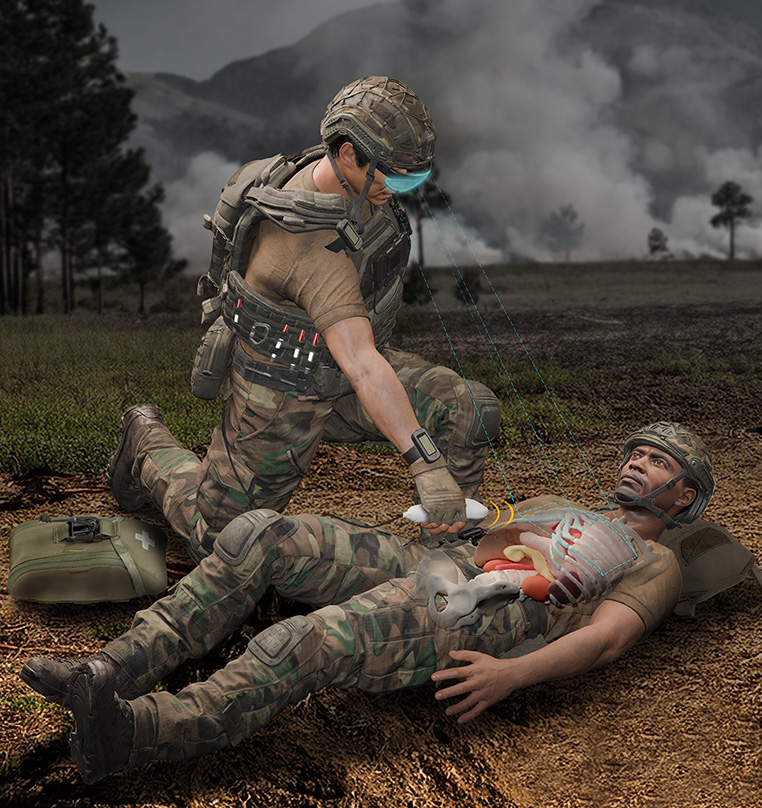News
Revolutionizing Battlefield Medicine: Augmented Reality for Lifesaving Trauma Care
Audio generated using AI voice technology.
In remote conflict zones and disaster-stricken areas, the nearest hospital is often hundreds of miles away. Medical teams face the tough task of providing critical care — with limited resources and while under constant threat — to casualties with wide-ranging medical needs.
Researchers at the Johns Hopkins Applied Physics Laboratory (APL) in Laurel, Maryland, are leveraging the power of augmented reality (AR), predictive anatomy visualization and artificial intelligence to provide field medics with a tool to deliver lifesaving care by helping them clearly visualize where internal organs are situated inside their patients’ bodies.
“The potential to save lives increases dramatically when you can pinpoint injuries quickly and accurately in any environment,” said Bobby Armiger, the project’s principal investigator and head of exploratory research at APL. “This tool could help to address a major challenge in field medicine, providing our medics with a visual map of an individual’s internal organs and guidance for emergency response procedures.”
This project sprang from the critical need to improve trauma care under constraints typical of battlefield conditions, Armiger said. Future shifts in American military engagements may necessitate prolonged care in the field, underscoring the need for advanced trauma care in austere environments.
“The changing dynamics of military operations often leave us without the advantages of air superiority and the ability to quickly evacuate to well-equipped medical facilities that we had during past conflicts,” he explained. “Our past strategy relied heavily on airlifting injured individuals to safety, but looking forward, we have to develop technologies that allow for more self-sufficient, immediate care on the battlefield and in remote areas.”
Virtually Visualizing Anatomy
The APL solution uses a statistical shape atlas — a detailed map of variations in human anatomy — to predict the likely location of internal organs based on external body landmarks. This predictive modeling is aided by AR technology, allowing medics to view an overlay of the patient’s internal anatomy directly on their body, which aids in making accurate assessments and interventions.
In other words, according to Anna Knight, an APL biomedical engineer who is leading medical image integration for the project, “These models allow medics to ‘see’ beneath the skin and predict where organs are situated.”
The concept for this AR-enhanced anatomical visualization tool grew from earlier uses of the statistical shape atlas in assessing the fit and coverage of body armor, Armiger noted. “Initially, the atlas was focused on improving soldier protection,” he said. “Now, we are adapting these concepts to focus on field medical diagnostics.”
APL’s extensive experience with statistical shape atlases enabled more precise predictions of organ locations, which are essential for accurately assessing different soldiers’ body types. That means moving beyond basic size categorizations to fine-tune medical assessments and interventions, Armiger said.
The team used deep-learning techniques to enhance the atlas with data from hundreds of CT scans, allowing for detailed anatomical predictions. An AR headset displays this information in real time during patient assessments.
“By understanding the external size and shape of an individual’s body, we can predict how the internal anatomy should appear,” Knight explained. “We then touch a couple of external spots —bony landmarks such as the sternum and the front-most points of the pelvis — and that allows us to use the headset to project where we predict that particular individual’s organs are.
“In the long term,” she added, “we’re hoping tools like this will allow medics to ‘punch above their weight’ in diagnosing and treating soldiers.”
Preliminary results have shown the ability to predict the individual shape of 66 different anatomical structures within the thorax. It’s important to note that the anatomical models are based on a dataset of 180 “healthy” CT scans. The scans were specifically chosen to represent the varying body shape types of the U.S. military population.
The team also developed a prototype heads-up display system for ultrasound recordings — complete with voice-activated commands — all within an AR environment. Integrating point-of-care ultrasound enables an eFAST (extended focused assessment with sonography for trauma) exam, which is a tool used to noninvasively, quickly and accurately diagnose internal bleeding or lung collapse due to blast or trauma. Incorporating an AR headset into the ultrasound allows for step-by-step visual guidance of the exam.
The goal is that even if the medic or operator has not been formally trained to perform an eFAST exam, they could be guided through the process to diagnose internal bleeding and perform triage. Further work will be conducted to characterize how well this will work in real-world situations where injuries such as blunt trauma are involved.
The procedural guidance extends to other possible medical interventions. For example, if a patient is experiencing a tension pneumothorax, or collapsed lung, due to trauma, the AR system could guide the medic through the steps for a needle thoracostomy, or needle decompression procedure.
While AR is not yet commonplace on the battlefield, applications like this are geared toward enhancing medic training in the near term and, in the future, may become a tool enabling future battlefield medicine to be delivered by any service member.
This project comes under an effort at APL to focus on “Assured Care,” which aims to counteract naturally occurring, deliberate and accidental health threats through groundbreaking science and engineering. This includes developing and implementing technologies that greatly enhance patient survivability in military and disaster scenarios.
By bridging the gap between innovative technology and practical application, this initiative embodies the Lab’s efforts to improve health crisis response, said Alan Ravitz, a chief engineer in APL’s Asymmetric Operations Sector.
“What we’re developing could one day contribute toward making care accessible wherever it’s needed most,” he said.
